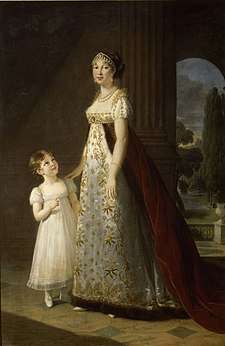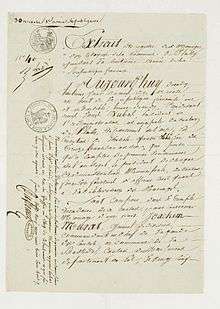Caroline Bonaparte
Maria Annunziata Carolina Murat (French: Marie Annonciade Caroline Murat; née Bonaparte; 25 March 1782 – 18 May 1839), better known as Caroline Bonaparte, was the seventh surviving child and third surviving daughter of Carlo Buonaparte and Letizia Ramolino, and a younger sister of Napoleon I of France. She was queen of Naples during the reign of her spouse there, and regent of Naples during his absence four times: in 1812-13, 1813, 1814 and 1815.
| Caroline Bonaparte | |||||
|---|---|---|---|---|---|
| Princess Murat Countess of Lipona | |||||
 Caroline Murat and her daughter Letizia in 1807. Painting by Élisabeth Vigée-Lebrun | |||||
| Grand Duchess consort of Berg and Cleves | |||||
| Tenure | 15 March 1806 – 1 August 1808 | ||||
| Queen consort of Naples | |||||
| Tenure | 1 August 1808 – 3 May 1815 | ||||
| Predecessor | Julie Clary | ||||
| Successor | María Isabella of Spain as Queen of the Two-Sicilies | ||||
| Born | 25 March 1782 Ajaccio, Corsica | ||||
| Died | 18 May 1839 (aged 57) Florence, Grand Duchy of Tuscany | ||||
| Spouse | Joachim, King of Naples Francesco Macdonald | ||||
| Issue among others... | Achille, Crown Prince of Naples Lucien, Prince Murat | ||||
| |||||
| House | Bonaparte | ||||
| Father | Carlo Buonaparte | ||||
| Mother | Letizia Ramolino | ||||
| Religion | Roman Catholicism | ||||
Early years

Caroline was born in Ajaccio, Corsica. She was a younger sister of Joseph Bonaparte, Napoléon Bonaparte, Lucien Bonaparte, Elisa Bonaparte, Louis Bonaparte and Pauline Bonaparte. She was an older sister of Jérôme Bonaparte.
In 1793, Caroline moved with her family to France during the French Revolution. Caroline was educated as a pupil at the school in St-Germain-en-Laye founded by Madame Jeanne Campan. She attended the school at the same time as Hortense, Joséphine's daughter and Caroline's brother Louis' wife.
She fell in love with Joachim Murat, one of her brother's generals, and they married on 20 January 1800. Caroline was seventeen years old. Initially, Napoleon did not wish to allow them to marry, however, his wife Joséphine de Beauharnais persuaded him to change his mind.
When Napoleon became Emperor, she and her sisters successfully asked to be made Imperial princesses.
Queen consort of Naples

Caroline became Grand Duchess of Berg and Cleves on 15 March 1806 and Queen consort of Naples on 1 August 1808, when her husband was appointed to the equivalent positions by her brother. According to the terms of the appointment, she would keep the title queen also after the death of her spouse.
As queen, Caroline renovated the royal residences in Naples, had new gardens planned, encouraged the growing interest in furniture of Classical design, patronized the silk- and cotton industry and French artists in Naples, showed an interest in the archaeological discoveries of Pompeii and founded a school for girls.
She was described as intensely jealous of her sister-in-law Joséphine and her children, reportedly because she felt Napoleon favored them over his Bonaparte relatives. It was reportedly Caroline who arranged for Napoleon to take a mistress, Éléonore Denuelle, who duly gave birth to his first illegitimate child.[1] This had the desired effect of establishing that Joséphine was infertile, as Napoleon showed he was clearly capable of siring children, which eventually resulted in his divorce from Josephine and remarriage. In 1810, when Napoleon married his second Empress Consort Marie Louise of Austria, Caroline was responsible for escorting her to France. After meeting her at the border of Austria and her duchy, Caroline forced Marie-Louise to leave all her luggage, servants, and even her pet dog, behind in Austria.
Caroline devoted herself to the interests of her husband Joachim Murat, the King of Naples, where she was very much involved in the affairs of the Kingdom. As queen of Naples, she functioned as the regent of Naples during the absence of Joachim on four occasions: during his participation in the war on Russia in 1812-1813, during his participation in the war in Germany in 1813, during the war against Napoleon in 1814, and, finally, during the return of Napoleon to power in 1815. In 1814, she supported his decision to make a separate peace with the anti-Napoleonic allies, keeping his throne while Napoleon was deposed.[2]
Then, during the Hundred Days of 1815, Joachim came out for Napoleon. During his absence, Caroline was left as regent of Naples. Joachim was defeated and executed, and Caroline fled to the Austrian Empire. Whilst in exile, she adopted the title 'Countess of Lipona'; 'Lipona' being an anagram of 'Napoli' (Naples).
Later life
In 1830, she married Francesco Macdonald (1777–1837), who had been Minister of War of the Kingdom of Naples in 1814 and 1815. She lived in Florence until her death in 1839. The couple had no children. Caroline died in 1839 and was buried at the Chiesa di Ognissanti, in Florence.
One of her great-great-great-grandsons was the American actor René Auberjonois, who was perhaps best known for voice acting Janos Audron in Legacy of Kain and portraying the character Odo on Star Trek: Deep Space Nine.
Issue
Caroline and Joachim were the parents of four children:
- Achille Charles Louis Napoléon Murat, 2nd Prince Murat (Paris, 21 January 1801 - Jefferson County, Florida, 15 April 1847), m. Tallahassee, Florida, 12 July 1826 Catherine Daingerfield Willis (near Fredericksburg, Virginia, 17 August 1803 - Tallahassee, Florida, 6 August 1867), daughter of Colonel Byrd C. Willis (29 August 1781 - 1846) and wife Mary Lewis, without issue;
- Princess Marie Letizia Joséphine Annonciade Murat (Paris, 26 April 1802 - Bologna, 12 March 1859), m. Venice, 27 October 1823 Guido Taddeo Pepoli, Marchese Pepoli, Conte di Castiglione (Bologna, 7 September 1789 - Bologna, 2 March 1852), and had one daughter;
- Lucien Charles Joseph Napoléon Murat, 2nd Sovereign Prince of Pontecorvo, 3rd Prince Murat (Milan, 16 May 1803 - Paris, 10 April 1878), m. Bordentown, New Jersey, 18 August 1831 Caroline Georgina Fraser (Charleston, South Carolina, 13 April 1810 - Paris, 10 February 1879), daughter of Thomas Fraser and wife Anne Lauton, and had issue; he was an associate of his first cousin Napoleon III;
- Princess Louise Julie Caroline Murat (Paris, 21 March 1805 - Ravenna, 1 December 1889), m. Trieste, 25 October 1825 Giulio Conte Rasponi (Ravenna, 19 February 1787 - Florence, 19 July 1876), had issue.
Ancestry
| Ancestors of Caroline Bonaparte | ||||||||||||||||||||||||||||||||||||||||||||||||||||||||||||||||||||||||||||||||||||||||||||||||||||||||||||||||||||||||||||||||||||||||||||||||||||||||||||||||||||||||||||||||||||||||||||||||||||||||||||||||||||||||||||||||||||||||||||||||||||||||||||||||||||||||||||||||||||||||||||||||||||||||||||||||||||||||||||||||||||||||||||||||||||||||||||||||||||||||||||||||||||||||||||||||||||||||||||||||||||||||||||||||||||||||||||||||||||||||||||||||||||||||||||||||||||||||||||||||||||||||||||||||||||||||||||||||||||||||||||||||||||||||||||||||||||||||||||||||||||||||||||||||
|---|---|---|---|---|---|---|---|---|---|---|---|---|---|---|---|---|---|---|---|---|---|---|---|---|---|---|---|---|---|---|---|---|---|---|---|---|---|---|---|---|---|---|---|---|---|---|---|---|---|---|---|---|---|---|---|---|---|---|---|---|---|---|---|---|---|---|---|---|---|---|---|---|---|---|---|---|---|---|---|---|---|---|---|---|---|---|---|---|---|---|---|---|---|---|---|---|---|---|---|---|---|---|---|---|---|---|---|---|---|---|---|---|---|---|---|---|---|---|---|---|---|---|---|---|---|---|---|---|---|---|---|---|---|---|---|---|---|---|---|---|---|---|---|---|---|---|---|---|---|---|---|---|---|---|---|---|---|---|---|---|---|---|---|---|---|---|---|---|---|---|---|---|---|---|---|---|---|---|---|---|---|---|---|---|---|---|---|---|---|---|---|---|---|---|---|---|---|---|---|---|---|---|---|---|---|---|---|---|---|---|---|---|---|---|---|---|---|---|---|---|---|---|---|---|---|---|---|---|---|---|---|---|---|---|---|---|---|---|---|---|---|---|---|---|---|---|---|---|---|---|---|---|---|---|---|---|---|---|---|---|---|---|---|---|---|---|---|---|---|---|---|---|---|---|---|---|---|---|---|---|---|---|---|---|---|---|---|---|---|---|---|---|---|---|---|---|---|---|---|---|---|---|---|---|---|---|---|---|---|---|---|---|---|---|---|---|---|---|---|---|---|---|---|---|---|---|---|---|---|---|---|---|---|---|---|---|---|---|---|---|---|---|---|---|---|---|---|---|---|---|---|---|---|---|---|---|---|---|---|---|---|---|---|---|---|---|---|---|---|---|---|---|---|---|---|---|---|---|---|---|---|---|---|---|---|---|---|---|---|---|---|---|---|---|---|---|---|---|---|---|---|---|---|---|---|---|---|---|---|---|---|---|---|---|---|---|---|---|---|---|---|---|---|---|---|---|---|---|---|---|---|---|---|---|---|---|---|---|---|---|---|---|---|---|---|---|---|---|---|---|---|---|---|---|---|---|---|---|---|---|---|---|---|---|---|---|---|---|---|---|---|---|---|---|---|---|---|---|---|---|---|---|---|---|---|---|---|---|---|---|---|---|---|---|---|---|---|---|---|---|---|---|---|---|---|---|---|---|---|---|---|---|---|---|---|---|---|---|---|---|---|---|---|---|---|---|---|---|---|---|---|---|---|---|---|---|---|---|---|---|---|---|---|---|---|---|---|---|---|---|---|---|---|---|---|---|---|---|---|---|---|---|---|---|---|---|---|---|---|---|---|---|---|---|---|---|
| ||||||||||||||||||||||||||||||||||||||||||||||||||||||||||||||||||||||||||||||||||||||||||||||||||||||||||||||||||||||||||||||||||||||||||||||||||||||||||||||||||||||||||||||||||||||||||||||||||||||||||||||||||||||||||||||||||||||||||||||||||||||||||||||||||||||||||||||||||||||||||||||||||||||||||||||||||||||||||||||||||||||||||||||||||||||||||||||||||||||||||||||||||||||||||||||||||||||||||||||||||||||||||||||||||||||||||||||||||||||||||||||||||||||||||||||||||||||||||||||||||||||||||||||||||||||||||||||||||||||||||||||||||||||||||||||||||||||||||||||||||||||||||||||||
Notes
| Wikimedia Commons has media related to Caroline Bonaparte. |
- Frances Mossiker "Napoleon and Joséphine, pp.282-84.
- Caroline Bonaparte
| Preceded by Julie Clary |
Queen consort of Naples 1 August 1808–3 May 1815 |
Succeeded by María Isabella of Spain as Queen of the Two-Sicilies |

2.svg.png)